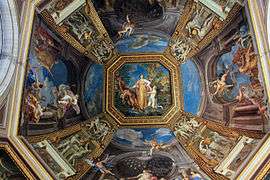Tommaso Conca
Tommaso Maria Conca (1734–1822), was an Italian painter and draftsman, active mostly in Rome.
Biography
He was born in Gaeta, one of the youngest of some eleven siblings, to Giovanni Conca and Anna Laura Scarsella di Castro. His father was a painter and cousin to the more famous painter Sebastiano Conca;[1] the two were Tommaso's first teachers in Baroque painting.[2] In 1770, Tommaso was made member of Accademia di San Luca, Rome's guild of painters.
_-_1775-1778.jpg)
From 1775 to 1782 he worked for Marcantonio Borghese, painting the ceilings of two rooms in the renovated Galleria Borghese, in collaboration with Giovanni Battista Marchetti.[1] In Sala del Sileno, above a Roman statue of Silenus he set scenes from that character, along with Bacchus and his followers.[3][4][5] In the Sala Egizia, dedicated to Egyptian sculpture, he represented the Nile, Cybele and astronomical bodies,[6] adorning the space between them with mock Egyptian idols;[7] on the walls he added eight scenes of Egyptian religion and the lives of Marcus Antonius and Cleopatra.[8]

Between 1782 and 1787 Conca painted Apollo and the Muses, a fresco decorating Sala delle Muse,[9] a room in the papal Museo Pio-Clementino.[10] At the end of his life, he completed another fresco in the Vatican's Museo Chiaramonti, which celebrates the restitution of paintings that had been taken to Musée Napoléon.[11]
Following Anton Raphael Mengs he shifted to a Neoclassical style.[12] One of his pupils was Camillo Guerra.
External links
| Wikimedia Commons has media related to Tommaso Conca. |
- Tommaso Conca on Personaggi di Roma database
References
- "CONCA, Giovanni". Dizionario Biografico degli Italiani (in Italian). 27. 1982.
- "Tomasso Maria Conca (Rome 1735 - Rome 1822)". Sphinx Fine Art. Retrieved 25 November 2013.
- "Sala 8 - Sala del Sileno" (in Italian). Ministero dei Beni e delle Attività Culturali e del Turismo. Retrieved 26 November 2013.
- Moreno, Paolo; Stefani, Chiara (2000). The Borghese Gallery. Touring Club Italiano. ISBN 9788836519460., pg. 184
- Paul, Carole (2000). Making a prince's museum: drawings for the late-eighteenth-century redecoration of the Villa Borghese. Los Angeles, CA: Getty Research Institute. ISBN 9780892365395., pg.75
- "Sala 7 - Sala Egizia" (in Italian). Ministero dei Beni e delle Attività Culturali e del Turismo. Retrieved 25 November 2013.
- The design referenced Raphael Anton Meng's work on the Sala dei Papiri in the Vatican library, which can be viewed on "Salle des Papyrus". Insecula. Retrieved 2013-12-07.
- Moreno and Stefani (2000), pg. 170
- "Hall of the Muses". Vatican Museums. Retrieved 23 November 2013.
- "Biography". Philadelphia Museum of Art. Retrieved 23 November 2013.
- "Figure 35". The Vatican Collections: The Papacy and Art. Metropolitan Museum of Art. 1982-01-01. p. 132. ISBN 9780870993213.
- "The Finding of Moses". Philadelphia Museum of Art. Retrieved 23 November 2013.